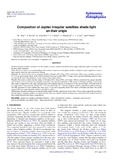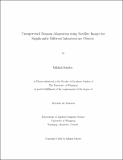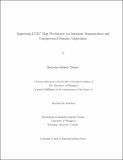Composition of Jupiter irregular satellites sheds light on their origin
Metadata
Show full item recordAuthor
Bhatt, M.
Reddy, V.
Schindler, K.
Cloutis, E.
Bhardwaj, A.
Corre, L. L.
Mann, P.
Date
2017Citation
Bhatt, M., V. Reddy, K. Schindler, E. Cloutis, A. Bhardwaj, L. Le Corre, and P. Mann (2017) Composition of Jupiter irregular satellites sheds light on their origin. Astronomy & Astrophysics, 608, A67. DOI: 10.1051/0004-6361/201630361.
Abstract
Context. Irregular satellites of Jupiter with their highly eccentric, inclined and distant orbits suggest that their capture took place after the giant planet migration.
Aims. We aim to improve our understanding of the surface composition of irregular satellites of Jupiter to gain insight into a narrow time window when our solar system was forming.
Methods. We observed three Jovian irregular satellites, Himalia (JVI), Elara (JVII), and Carme (JXI), using a medium-resolution 0.8–5.5 µm spectrograph, SpeX on the NASA Infrared Telescope Facility (IRTF). Using a linear spectral unmixing model we have constrained the major mineral phases on the surface of these three bodies.
Results. Our results confirm that the surface of Himalia (JVI), Elara (JVII), and Carme (JXI) are dominated by opaque materials such as those seen in carbonaceous chondrite meteorites. Our spectral modeling of NIR spectra of Himalia and Elara confirm that their surface composition is the same and magnetite is the dominant mineral. A comparison of the spectral shape of Himalia with the two large main C-type asteroids, Themis (D ~ 176 km) and Europa (D ~ 352 km), suggests surface composition similar to Europa.
The NIR spectrum of Carme exhibits blue slope up to 1.5 µm and is spectrally distinct from those of Himalia and Elara. Our model suggests that it is compositionally similar to amorphous carbon.
Conclusions. Himalia and Elara are compositionally similar but differ significantly from Carme. These results support the hypotheses that the Jupiter’s irregular satellites are captured bodies that were subject to further breakup events and clustered as families based on their similar physical and surface compositions.
Collections
Related items
Showing items related by title, author, creator and subject.
-
Unsupervised Domain Adaptation using Satellite Images for Significantly Different Infrastructure Objects
Sokolov, Mikhail (University of WinnipegUniversity of Winnipeg, 2022-03-28)Deep learning has become one of the most efficient computer vision tools in recent years. The success and variety of deep learning semantic segmentation models inspired scientists in the remote sensing domain to apply them ... -
Comparing Two Species Distribution Models Using Satellite Only and Ready-Made Environmental Variables for the Dakota Skipper (Hesperia dacotae), Interlake Region of Manitoba, Canada
Murray, Colin (University of WinnipegUniversity of Winnipeg, 2024-04-17)The Dakota skipper, Hesperia dacotae (Skinner, 1911) [Hesperiidae, Lepidopterida] is a rare prairie obligate butterfly with an affinity for anthropogenically undisturbed, grassland habitat with diverse native flora. ... -
Improving LULC Map Production via Semantic Segmentation and Unsupervised Domain Adaptation
Tsenov, Rostyslav-Mykola (University of WinnipegUniversity of Winnipeg, 2021-04-13)In recent years, a lot of remote sensing problems benefited from the improvements made in deep learning. In particular, deep learning semantic segmentation algorithms have provided improved frameworks for the automated ...




